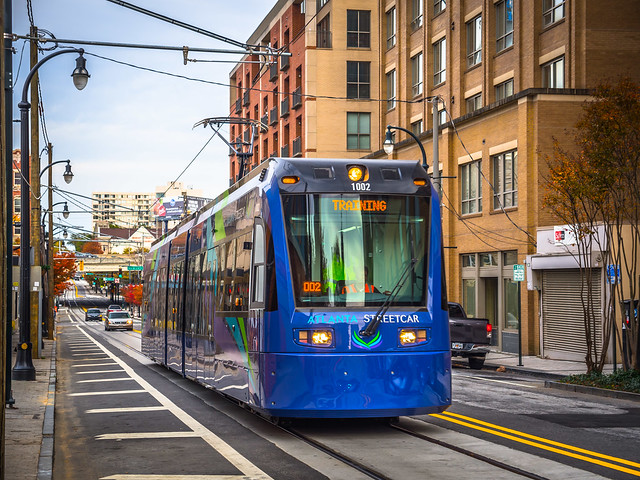Atlanta falling behind as a "capital" of the South
The Atlanta Journal-Constitution (temporarily providing full open access to articles normally behind a paywall) ran a series assessing the state of the city, specifically comparing Atlanta to Charlotte, a leading financial center, and Dallas-Fort Worth.
Sunday: A big-picture comparison of Atlanta with its perennial economic competitors, Charlotte and Dallas.
Monday: A deep look at Dallas-Fort Worth’s Texas-sized ambitions compared against metro Atlanta’s.
Tuesday: Charlotte’s turn under the microscope. While the market is smaller, its vibrant downtown is enviable.
 The Margaret Hunt Hill Bridge--designed by Santiago Calatrava--connects Downtown Dallas to the Trinity River Corridor Project and is now a defining element of the city skyline. Flickr photo by Mabry Campbell.
The Margaret Hunt Hill Bridge--designed by Santiago Calatrava--connects Downtown Dallas to the Trinity River Corridor Project and is now a defining element of the city skyline. Flickr photo by Mabry Campbell.While Atlanta is doing better than many cities, it lags both Charlotte and Dallas-Fort Worth on many indicators including income, attraction of younger demographics, number of college degrees, poverty, etc.
From "The ups and downs of a great city [Cleveland]":
- Metro Atlanta’s overall economy as measured by GDP is down nearly a full percentage point since 2007. Charlotte’s is up 10 percent. Dallas’ has risen 14 percent.
- Atlanta last year employed 4 percent fewer people than prior to the recession. Dallas employed 8 percent more, Charlotte 6 percent more.
- Average weekly wages in metro Atlanta remain 6 percent below pre-recession levels, while in Charlotte and Dallas they‘ve dropped 3 percent or less.
- Metro Atlanta home prices remain 13 percent below the pre-recession peak. In Dallas, they’re 13 percent above peak.
- Atlanta’s suburban poor population jumped 159 percent between 2000 and 2012 — the largest increase in the nation.
Dallas and Fort Worth in particular have many high profile public and private projects underway, from light rail expansion and efforts in both cities to better leverage the presence of the Trinity River as a place to live, work, and play.
Some of the people quoted state that unlike other Southern cities, Atlanta doesn't stand out in having a competitive advantage in specific sectors, such as Nashville and entertainment, Charlotte in finance, or Raleigh in health care.
 Atlanta Streetcar by Central Atlanta Progress, on Flickr.
Atlanta Streetcar by Central Atlanta Progress, on Flickr.By contrast, the State of Georgia has not been helpful to its leading city, especially when it comes to public transit and other infrastructure development.
However, Clayton County has joined MARTA, the area's transit authority, in December the City of Atlanta launched modern streetcar service, being the first city on the East Coast to do so, the Port of Savannah is being expanded, and the city's Beltline project is moving forward.
-- MARTA's push for bus service"
Meanwhile, Mercedes-Benz is moving its headquarters to suburban Sandy Springs from New Jersey, suburban-based NCR is moving to Midtown Atlanta, but the Atlanta Braves are relocating to Cobb County, even as a new stadium is being built for the Atlanta Falcons football team.
I do think the issue in part is, as discussed in the article on Charlotte, "cityness" or lack thereof. Charlotte has focused development downtown (which they call Uptown) and so there is a four square mile comparatively dense mixed use center that is increasingly attractive.
Atlanta too is a small city, and the bulk of population growth and economic activity has shifted to the suburbs--even the newspaper moved of the city--and the automobile dominates the mobility paradigm.
Labels: transportation planning, urban design/placemaking, urban revitalization




5 Comments:
Looks as if I missed most of the series, the window closed.
In terms of comparing to Cleveland, while there were many many mistakes, the global economy is what really walloped the region.
While the big names (steel, cars) hurt, they also missed out the real lifeblood of the industrial economy there machine tools. German tool makers did survive.
Looking at Atlanta, the striking number is lowest number of young people (ahead of Detroit and Cleveland)
That is off the charts.
A lot of the rest is just boom/bust. Way too much building in the SUV era. I don't see a giant secular shift away from Atlanta's economy.
Absolutely right about city/state relations, terrible.
the articles weren't so scintillating that you missed very much.
What I liked was the overall thrust, that the city shouldn't sit on its laurels, that it needs to set a high bar for "reference" or comparison cities.
I think about Balt. County a lot on this metric. It is self-satisfied almost always because it only seems to really compare itself economically to Baltimore City, a comparison it will always win because of the significant difference in the number of extremely impoverished.
But Balt. County, to win on a 21st century basis, needs to compare itself to a stronger set of comparison jurisdictions.
http://www.aei.org/publication/new-census-bureau-data-young-adults-provide-fascinating-insights-forces-creative-destruction/
will read, thx.
Thank you for providing such valuable information and thanks for sharing this matter.
Post a Comment
<< Home